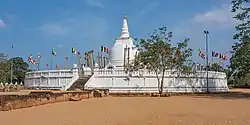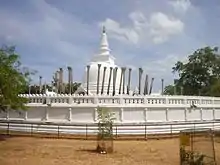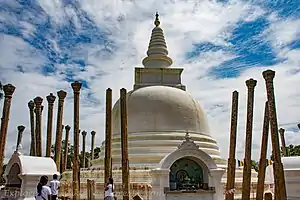Thuparamaya
Thuparamaya is the first Buddhist temple in Sri Lanka. Located in the sacred area of Mahamewna park, the Thuparamaya Stupa is the earliest Dagoba to be constructed in the island, dating back to the reign of King Devanampiya Tissa (247-207 BC).[1] The temple has been formally recognised by the Government as an archaeological site in Sri Lanka.[2]
| Thuparamaya | |
|---|---|
ථූපාරාමය | |
 The Stupa | |
| Religion | |
| Affiliation | Theravada Buddhism |
| District | Anuradhapura |
| Province | North Central Province |
| Location | |
| Location | Anuradhapura |
| Country | Sri Lanka |
| Geographic coordinates | 8°21′19″N 80°23′46″E |
| Architecture | |
| Type | Buddhist Temple |
| Founder | King Devanampiya Tissa (247-207 BC) |
| Width | 4 |
History

Mahinda Thera, an envoy sent by King Ashoka himself introduced Theravada Buddhism and also Chaitya worship to Sri Lanka. At his request King Devanampiya Tissa built Thuparamaya in which he enshrined the right collar-bone of the Buddha.[3][4] It is considered to be the first dagaba built in Sri Lanka following the introduction of Buddhism and also the earliest monument, the construction of which was chronicled. The name Thuparamaya comes from "stupa" and "aramaya" which is a residential complex for monks.
According to the Palumekichchawa Inscription, the tank called Madamanaka (Palumekichchawa Wewa) at Upala Vibajaka area had been constructed at a cost of 5000 Kahavanu and donated on behalf of the Bhikkus who were living at the Thuparama temple. It further states that the harvest from the paddy fields surrounding the tank was presented to the Bhikkus at the temple. The inscription is the earliest chiseled stone inscription in which the name of the Thuparama temple is inscribed, and said to belong to the reign of King Gajabahu (114-136 A.D.).[5]
The Stupa
Thuparamaya dagoba has been built in the shape of a bell. This dagoba was destroyed from time to time. During the reign of King Agbo II it was completely destroyed and the King restored it. What is seen presently is the construction of the dagoba, done in 1842 AD.[6] As of today, after several renovations, in the course of the centuries, the monument has a diameter of 59 ft (18 m), at the base. The dome is 11 feet 4 inches (3.45 m) in height from the ground, 164 1⁄2 ft (50.1 m) in diameter. The compound is paved with granite and there are 2 rows of stone pillars round the dagaba. During the early period, a vatadage was built around Thuparamaya.

See also
References
- Gunawardena, C. A. (2003). Encyclopedia of Sri Lanka. Sterlin Publishers Pvt. Ltd., New Delhi-110020. p. 290. ISBN 81-207-2536-0.
- "Archaeological Sites (Map)". Department of Archaeology. Retrieved 20 September 2017.
- De Thabrew, W. Vivian (2013). Monuments and Temples of Orthodox Buddhism in India and Sri Lanka. AuthorHouse. p. 59. ISBN 9781481795517.
Accordingly the right collar-bone of the Buddha was received with great veneration and pomp and enshrined
- Royal Asiatic Society of Sri Lanka, Royal Asiatic Society of Great Britain and Ireland. Sri Lanka Branch (1990). Journal of the Royal Asiatic Society of Sri Lanka, Volume 33. Royal Asiatic Society of Sri Lanka. p. 10.
...to the building of the Thuparamaya, the first stupa to be built in Lanka to enshrine the right collar-bone relics of the Great Teacher (Buddha).
- "To protect oldest stone inscription Irrigation Dept constructs wall". Ceylon Today. Ceylon Newspapers (Private) Limited. 11 September 2017. Retrieved 20 September 2017.
- "සෙල්ලිපියට කොන්ක්රීට් දැමූ පින්වතුන්! (In Sinhala)". Deshaya. Wijeya Newspapers. 16 September 2017. Retrieved 20 September 2017.
- This page incorporates content from Dr. Rohan Hettiarachchi's http://www.lankalibrary.com/ used with permission of website owner.
External links
| Wikimedia Commons has media related to Thuparamaya. |